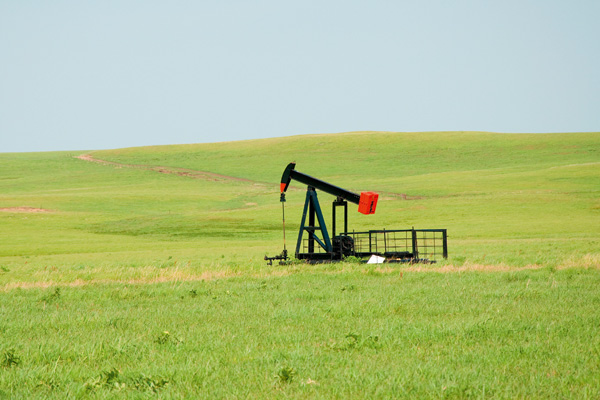Oklahoma will always be a red state on the political map, but the colour goes deeper than that. Everything here was red: red earth, red brick, red dust, red rust. At Little Sahara State Park, 1,600 geologically anomalous acres of iron-rich sand dunes were pinky-orange, the colour of thousand-island dressing.
The sitcom Friends had a storyline in which a character accidentally went to Oklahoma, the implication being that that’s the only reason anyone would go there. The state’s position as an unfashionable backwater became a running joke over eight episodes, after which the Friend headed back to civilisation.
It was not always thus. So-called ‘wildcatters’ were poking around in the red dirt for black gold at the beginning of the last century. In November 1905, two such prospectors, chancing their arm on Indian land just south of Tulsa, hit the jackpot with what was at the time the world’s biggest oil strike. The city’s short-term prosperity and inevitable decline were guaranteed. The population rocketed, the business moved in, and for the next half-century, Tulsa could legitimately call itself the ‘Oil Capital of the World’.
Any director looking to shoot a Roaring Twenties drama on the cheap should bypass Chicago and head here
Oil made millionaires out of corporate swells who relished the opportunity to raise an urban landscape from the prairie. Tulsa hit the big time when art deco was the thing: though the oil barons long ago moved on to Houston and Dallas, they left behind a downtown crammed with skyscrapers and architectural treasures.
The beauty of it is that most of them are public buildings now: anyone can wander into the spectacular lobbies for a gawk. Even in the Bank of Oklahoma, no one protested as I ran around taking photos. Out of office hours, you may find the security guards are just happy to have someone to talk to. One became my unofficial tour guide, drawing my attention to a ceiling detail here or an old-fashioned set of weighing scales there. Any director looking to shoot a Roaring Twenties-set drama on the cheap should bypass Chicago in favour of Tulsa.
A few minutes’ walk from downtown is the Boston Avenue United Methodist Church, completed in 1929 and Tulsa’s most sheerly beautiful edifice. Its angled arches and stylised limestone Wesleys, beneath a tower as tall as Westminster Abbey’s, evidently spring from a branch of Methodism which no ascetic Welshman would recognise. Inside, no candlestick is carelessly placed, no lampshade unfrosted. But the decor is seemly, not showy, and never tips over into tastelessness: the sanctuary is dominated by a vast 750,000-piece mosaic behind the choir loft in peaceful shades of lilac and grey.
Not for nothing is Tulsa known as ‘the buckle on the Bible Belt’, though the city’s money-worshippers have snuck in a false idol: no golden calf, but the Golden Driller, the world’s largest free-standing statue. A 76-foot oilman leaning on a derrick outside the Tulsa Expo Center, he looks oddly Stakhanovite given the raw capitalism he represents.
Not far outside town is Tallgrass Prairie Preserve, where the buffalo really do roam. Except they don’t, or at least not while I’m there (it’s 114 degrees today). The lady at preserve headquarters points out that, given the heat, the herd are hiding among the trees, where there is shade. So prairie dogs, jackrabbits, wild turkeys, encouraging cowpats, yes. Buffalo, no. I am beginning to think the whole thing is a ruse to send gullible furriners down miles of unpaved road looking for animals hunted to extinction decades ago.
Instead, the farmland is dotted with droves of what the locals call ‘nodding donkeys’, the perpetual-motion beam pumps that bring the crude to the surface. Forty minutes’ drive north among these peculiarly Oklahoman livestock, where every stop along the road is less a town, more a grain silo with a zip code, brings you to Bartlesville, the unlikely home of a Frank Lloyd Wright masterpiece.
As an architect of the flat prairie, Wright thought horizontally, not vertically. Only once did he design what could be described as a skyscraper, commissioned late in his career to build a corporate headquarters for pipeline magnate Harold C. Price. The result, completed in 1956 when Wright was 88, is the Price Tower. Sounds like a supermarket, doesn’t it? The building is only 19 storeys tall, barely more than a bungalow in New York, but out here on the south-western plains it’s visible for miles. No wonder its creator called it ‘the tree that escaped the crowded forest’. All the tower’s original fittings remain. Office space still occupies several floors (though the Price Company moved out in 1981), and one can only envy the worker bees who pass through Wright’s lustrous lobby every day. Lord knows Price could afford luxury, but to look round his office and the family apartment is to understand the difference between good design and opulence for its own sake.
Wright and his employer frequently clashed over the building’s contents, but it looks like Wright prevailed: Don Draper’s southern cousins would rue the absence of a comfortable couch on which to sleep off that three-martini lunch. But the Copper Bar on the 15th floor might at least serve him a hair of the dog. Did I mention that three floors have been converted into suites of guest rooms, decorated in a suitably mid-century fashion? Here is proper comfort, and a convenient bed for the late-night over-indulger. I contented myself with a cocktail and the Osage County sunset, turning this red state redder still.





Comments